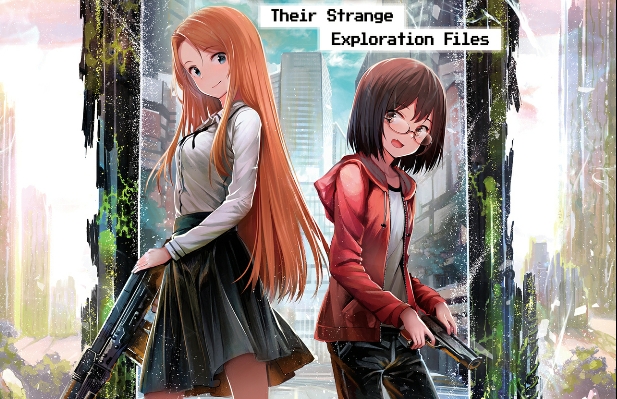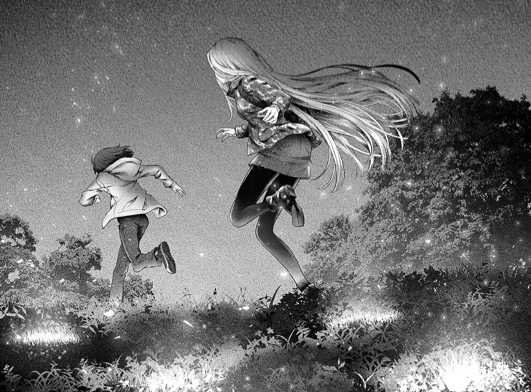Books: Otherside Picnic
June 13, 2022 · 0 comments
By Shelley Pallis.

Sorawo Kamikoshi is a loner, a twenty-year-old nerd studying cultural anthropology at a Saitama university, whose hobby is exploring spooky places. Nor are these randomly and doubtfully “haunted houses” – she has found numerous portals to an alternate world, the titular “Otherside” where all sorts of rumours, urban legends, horror stories and other Forteana have come to life.
On one of her trips, she bumps into Toriko Nishina, a former special-forces army brat from Canada who is searching the Otherside for her missing friend. The two women swiftly team up in a faint echo of The X-Files, in Iori Miyazawa’s Otherside Picnic – an action-woman and a bookworm, poking around a series of mysteries-of-the-week, many derived from Internet memes. This, itself, is something of a fascinating glimpse of a youth subculture – the sort of stuff that is common knowledge to modern teenagers, but will have passed many of their elders by. The Kunekune, for example, a wriggly, white humanoid figure occasionally glimpsed in summer-time rice fields, an encounter with which not only spooks the hell out of them, but also seems to physically mark them. Others, like the kamikakushi (those who have been “spirited away”) are legends with a longer pedigree. In one particularly interesting encounter, they run into a platoon of modern-day US Marines, mysteriously transported from Okinawa to Tokyo, with no idea how they got there. They and the heroines find themselves in Kisaragi Station, a stop on the Tokyo subway that doesn’t actually exist…
On which note, there is a strange tone in the book. Translator Sean McCann is unable to resist that “spirited away” coinage, presumably because that, after all, is where most readers in English are liable to have first seen the term crop up, in the Miyazaki movie of the same name. But elsewhere, the references, seemingly in the original Japanese, are irritatingly coy. A character drinks from a mug with “a piece of Tove Jansson art on it”, as if the Copyright Police will kick the door down if someone says Moomin.

By the time we first encounter them, Sorawo and Toriko have already blundered over the threshold from being tourists in occasional scary stories, to being two women actively risking their lives. Since Sorawo isn’t that much of a bookworm after all, or indeed, much of a cultural anthropologist, they are soon a trio, with the addition of Kozakura the glum but Internet-savvy blogger. The US Marines, too, become part of the team for a while, although the fact that there is no record of their “Palehorse” unit makes Toriko suspect that they are dealing with an off-the-books black-ops team, or even possibly an X-filey sort of division which the US government will insist on denying.
I can easily see how this book series got an anime upgrade in record time. If The X-Files is something that your Dad watched, and most of the information you get about the world comes through your phone, then this is surely an original and compelling mystery series. Bite-sized individual chapters work well as episodic stand-alones, but all the while, the heroines are building a sense of what the Otherside actually his, how it all fits together, and perhaps even how they might be able to locate Toriko’s missing friend. There’s also a little side-effect – the fact that you can leave the Otherside in a different place from where you entered it risks becoming this generation’s supernatural version of bucket airlines and budget buses.
If I have any gripes, it’s that the author’s afterword makes a big deal of discussing his sources, most of which seem to be creepypasta and online chat threads from 2chan, along with a couple of relatively recent books about the paranormal. Nor is the book’s research all that accurate – Sorawo claims, for example that the Kunekune story first circulated in 2003, whereas the real-world Wikipedia places it as a 2-chan myth from 2001. In other words, much as his protagonist seems to rarely stray much further than Wikipedia in her “research”, Miyazawa gives the impression of being so enmeshed in specifically Millennial urban legends because those are all he’s ever seen. Lucky for him that Miyazaki made that movie, eh!
That’s all very well, but I’d rather hoped he would have at least mentioned the rather obvious influence of the Russian sci-fi novel Roadside Picnic (1972) by the Brothers Strugatski, which similarly involved episodic explorations of Forteana, in that case left behind by unseen alien visitations. The fact that Miyazawa could spend three pages wittering about his inspirations, and making such a big deal of acknowledging them, without once bringing this up, left me with a bitter aftertaste, as if he, like too many other light-novel writers, regards novel-novels as something for him to crib from, not for you to want to read.
Otherside Picnic is published by J-Novel Club and available in the UK from Anime Limited.
Leave a Reply